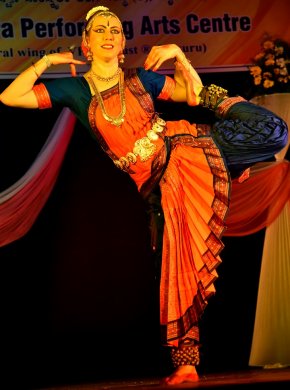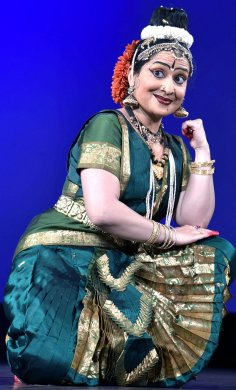
|   |

|   |
Authenticity in Bharatanatyam - Dr. M. Surya Prasad e-mail: drmsuryaprasad@gmail.com February 23, 2019 It is heartening to note the popularity of Indian classical art forms abroad. Non-Indians have well perceived the importance of these forms in one's physical and mental development. The nuanced Indian cultural ethos and philosophy seem to have captivated them. A good number of foreign dancers is taking to Indian classical dances and proving their mettle through their neat performances. The Indian dance teachers on their part have developed admirable technique and skills in imparting the subtleties of the dance forms. These thoughts flitted across my mind while witnessing a compact Bharatanatyam recital by proficient dancer Ruric Amari Rich from USA at Jaganmohan Palace Auditorium, Mysuru. She is blessed to have found a versatile and consummate performer/guru Dr. Vasundhara Doraswamy of Vasundhara Performing Arts Centre, Mysuru, who taught her not just to move her body beautifully for performance on stage, but also to connect with the mythological stories through dance. Her animated face could emote many a feeling. It is noteworthy that the deep study and research of Dr. Vasundhara Doraswamy have resulted in her own style of Vasundhara bani of Bharatanatyam, a distinct and coherent blend of Yakshagana, Yoga and Bharatanatyam. Undoubtedly, the disciplined teaching and the committed learning of Ruric Amari Rich paid rich dividends. Accompanied inspiringly by Vasundhara Doraswamy (nattuvangam), Deepthi Srinath (vocal), Tandavamurthy (violin), Hanumantharaju (mridangam) and others, in the opening chaturashra alarippu, Ruric saluted the remover of obstacles in a clear cut imagery of his various forms like Mooshikavaahana, modakahastha and so on. Vasundhara bani's important features came into light when yoga and Surya Namaskaram (Suryaashtaka) were added to it. Her anga shuddhi was excellent with refined hand and leg stretches, shira and greeva bedhas intact. Interspersed with taut nritta with a profusion of varied jathis and adavus, she sketched Papanasam Sivan's krithi "Gajavadana" (Sriranjini) in praise of Lord Ganesha. Full marks could be awarded for the presentation of Charukesi varnam which revolved around Valli, Devayani and Shanmukha. The virahotkhanthita nayika's plight and moods were effectively brought to the fore in an admirable abhinaya session. In the portrayal of Purandaradasa's "Pogadiralo Ranga" (Shankarabharanam), child Krishna and Yashoda's interactions were vividly sketched through various sancharis. Ruric was at home in negotiating the subtleties of nritta, nrithya and abhinaya elements of Bharatanatyam with ease. Confident and composed, she won the accolades of the rasikas with her artistry and skill. Her fine emphasis on powerful footwork matched the complex rhythmic cycles of the onstage musicians. The multitude of facial expressions and finely honed gestures allowed the practitioner to incarnate multiple personalities and emotions. Ruric's performance was marked by passion, technical precision and gestural clarity.  Ruric Amari Rich  K.S. Pavithra The main language of dance is movement (chalane) and enactment (abhinaya). Various bhavas and rasas are expressed through abhinaya. In a dance feature, the inputs of a poetry or song (though they are heard) are made a visual experience through movement by the dancer. Such being the case, it becomes a great challenge for the dancer/choreographer to adapt a literary work (sahitya krithi) - basically which is not created for dance -- to classical dance. The dancer will have to exercise caution in the selection of parts of the work. What is told in many pages and words (vachya) has to be expressed in a nutshell through succinct symbolism (sanketika). In solo dance features it calls for more and more profundity in natya and abhinaya. The lone dancer instantly transforms into contrasting characters and bhavas. The art of projection of bahuroopatva and the sudden shifts come to the fore. A prolific performer and choreographer, Dr. K.S. Pavithra of Sri Vijaya Kala Niketana of Shimoga seems always to be eager and successful in marking out new dimensions in the presentation of Bharatanatyam. On the occasion of the fiftieth year of Jnanapeetha award to Kuvempu's Sri Ramayana Darshanam, Pavithra chose to present it in her own psychological vision. She was at the helm of her artistry when she unfolded different characters and the tale of Ramayana on the basis of Kuvempu's work at Seva Sadan, Bengaluru. Though it was an ekaaharya eka vyakti pradarshana, Pavithra stole the show with her innate talent. The varied mental status, behaviour, thoughts and actions of the main characters of the epic were captured in vivid and sensitive abhinaya. The possible monotony was intelligently and meaningfully broken with the insertion of pure dance sequences. The presentation began with Guruvandane and sketching of Valmiki Maharishi. Then it proceeded with the expositions of different popular episodes and characters of Ramayana as envisaged by Kuvempu. Her expertise in psychology came handy in the researched portrayal. Pulikeshi (nattuvangam), Vasudha (vocal), Janardhan (mridangam), Rakesh (flute) and Skanda (rhythm pads) gave her musical support. Dr. M. Surya Prasad is a tri-lingual music and dance critic of Karnataka, scholar, organizer, educationist, researcher and translator. |